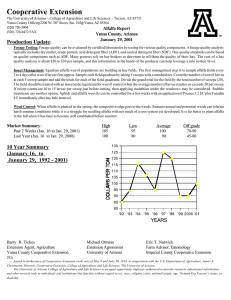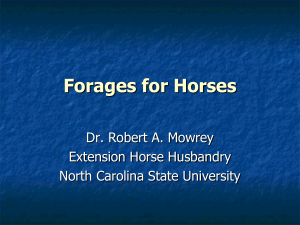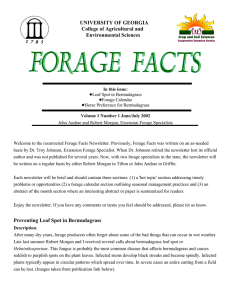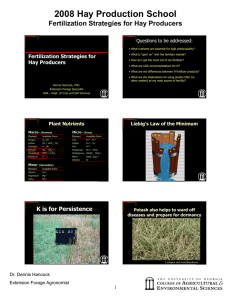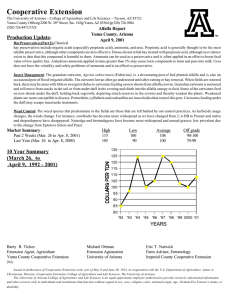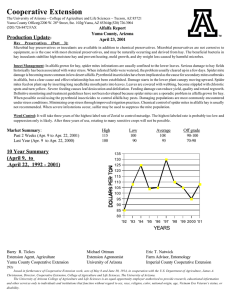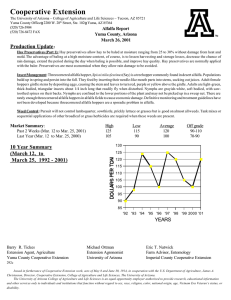2008 Hay Production School Recommendations in selecting and establishing a hay crop
advertisement
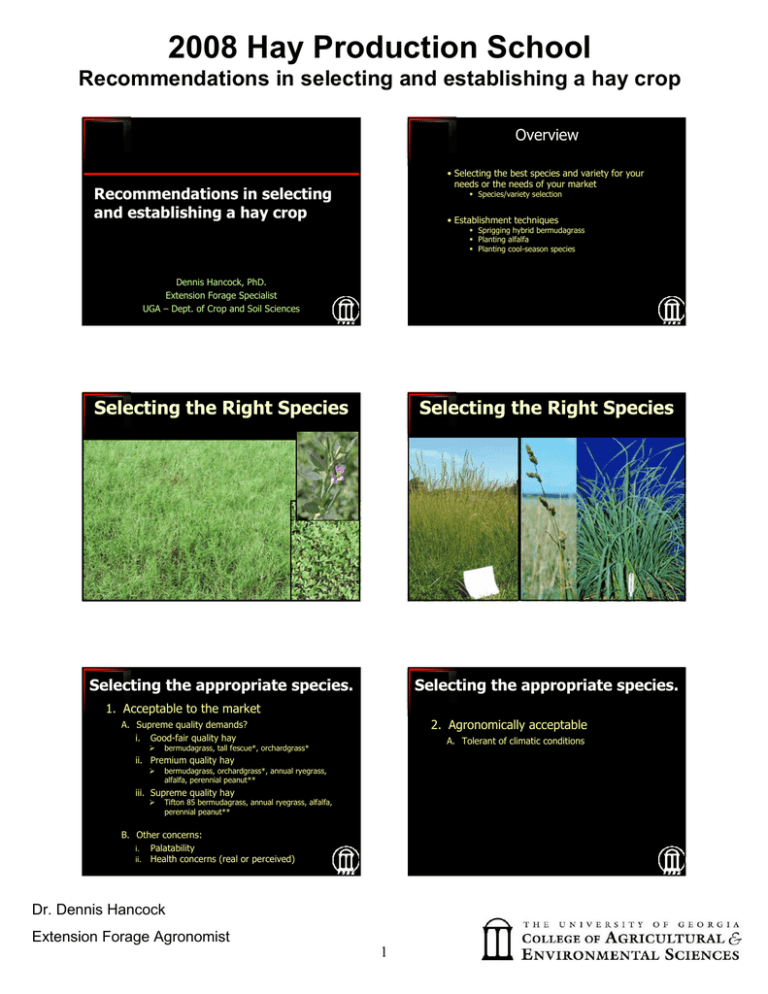
2008 Hay Production School Recommendations in selecting and establishing a hay crop Overview • Selecting the best species and variety for your needs or the needs of your market Recommendations in selecting and establishing a hay crop Species/variety selection • Establishment techniques Sprigging hybrid bermudagrass Planting alfalfa Planting cool-season species Dennis Hancock, PhD. Extension Forage Specialist UGA – Dept. of Crop and Soil Sciences Selecting the Right Species Selecting the Right Species Selecting the appropriate species. Selecting the appropriate species. 1. Acceptable to the market 2. Agronomically acceptable A. Supreme quality demands? i. Good-fair quality hay ¾ A. Tolerant of climatic conditions bermudagrass, tall fescue*, orchardgrass* ii. Premium quality hay ¾ bermudagrass, orchardgrass*, annual ryegrass, alfalfa, perennial peanut** iii. Supreme quality hay ¾ Tifton 85 bermudagrass, annual ryegrass, alfalfa, perennial peanut** B. Other concerns: i. Palatability ii. Health concerns (real or perceived) Dr. Dennis Hancock Extension Forage Agronomist 1 2008 Hay Production School Recommendations in selecting and establishing a hay crop Rainfall Distributions Regional Possibilities 1 2 3 4 - Orchardgrass (1, but risky) - Tall Fescue (1, risky in 2, 3) - Bermudagrass (all, with right variety) - Alfalfa (all, best w/ irrigation) - Perennial peanut (5, risky in 4) 1 5 Rainfall Distribution - Midville Selecting the appropriate species. 2000-2007 8.0 2. Agronomically acceptable Average Monthly Rainfall (inches) 1 A. Tolerant of climatic conditions i. tall fescue (not in S. Piedmont, Coastal Plain) ii. perennial peanut (not in Upper Coastal Plain or N) B. High yields C. Performance under irrigation D. Vigorous establishment E. Soil fertility demands i. Especially high in alfalfa and bermudagrass F. Appropriate to your management 6.0 4.0 2.0 Ja nu F e a ry br ua r M y ar ch Ap r il M ay Ju ne Ju A ly Se u g pt u s t em b O er c N to b ov e r e D mb ec er em be r 0.0 Species, Soil, and Management Best Selecting the appropriate variety. Perfection Choosing the right variety is a critical decision. Soil Conditions Alfalfa Ber mu dag ras s P er en n ial P e an u • Yields Total Yields (multi-year) • Quality • Winter Hardiness • Persistence Yields in 3rd or 4th year Stand ratings • Disease resistance t Best Poor Management Skill Dr. Dennis Hancock Extension Forage Agronomist 2 2008 Hay Production School Recommendations in selecting and establishing a hay crop Hybrid Bermudagrass Yields at Calhoun 2003-2005 Variety Trial Comparisons Mean Annual Yield lb DM/acre a* 22000 20000 18000 16000 14000 12000 10000 8000 6000 4000 2000 0 b Tifton Tifton 85 85 Russell Russell bc Alicia Alicia cd Tifton Tifton 44 44 d Coastal Coastal Variety Varieties labeled with the same letter were not significantly different (α=0.05). Selecting the appropriate species. Palatability of Bermudagrasses Highly acceptable: Coastal = Tifton 44 = Tifton 78 (= Russell) Acceptable if given no other choice: Tifton 85 Coastcross Selecting the Right Alfalfa Variety Drying Rate of Bermudagrasses • Dormancy rating of 5 to 8. Rating (1-10) based on growth after September 1. Winter survival in the North. Fastest Drying • Disease resistance: > MR to Tifton 44 >= Coastal >= Russell phytophthora root rot (PRR), anthracnose (An), bacterial wilt (Bw), and fusarium wilt (Fw), as well as a R rating to aphanomyces root rot (APH). (any differences driven by mass) Delayed by ½ to 1 full day (thicker stems) Tifton 78 >= Coastcross I or II >= Tifton 85 • Varieties: Bulldog 505 or 805 Dr. Dennis Hancock Extension Forage Agronomist 3 2008 Hay Production School Recommendations in selecting and establishing a hay crop Selecting the Right Perennial Peanut Variety • Disease resistance: Peanut Stunt Virus – all are susceptible. Establishment • Varieties: Florigraze > Arbrook Florigraze is more cold-hardy and responsive to irrigation. Arbrook is slightly faster to establish, but is slower to spread laterally. Stem size: Arbrook > Florigraze Prepared Seedbed Thou Shalt Soil Test • “Well-prepared” seedbed Plow/disc/finish at least 2-4 wks prior to sprigging Incorporate lime, phosphorus, and potassium. Incorporate PPI herbicide. Allow time to settle or firm with cultipacker/roller. • Seedbed should be firm Boot tracks should be ~1/4 in. deep If too fluffy, the soil will dry very quickly (sandy soils) The #1 cause of poor stands at establishment – poor soil fertility or low soil pH. Minimum Till (“No-till”) • Acceptable for vegetative establishment (sprigging), at least in Piedmont. • PPI weed control? Dr. Dennis Hancock Extension Forage Agronomist 4 2008 Hay Production School Recommendations in selecting and establishing a hay crop Establishing Hybrid Bermudagrass “No-till” Best methods • Best when terrain is rolling or soil is at risk of erosion. 1) Dormant sprigs (rhizomes) - 40-50 bu/A ¾ Dec. to early Mar. • Primarily used for seeding or interseeding 2) Sprigs with green tops – 30-50 bu/A • Not feasible for vegetative establishment (sprigging). 3) Tops/green stems – 50-60 bu/A ¾ ¾ ¾ spring (after last freeze) to early Aug. Jun. – Aug. Not recommended for Tifton 44 • Best if seedbed is well-prepared Planting Alfalfa How Much is a Bushel of Sprigs? Using Two 5-gallon Buckets Best methods: Coastal Plain 1) Well-prepared, very firm seedbed Pack-plant-pack method 50 lb weight – Broadcast or Drilled – Cultipacking seeder (Brillion) Line at 4 in. Sprigs 2) (Distant) No-till into suppressed sod Acceptable if interseeding into bermudagrass sod 1 bu Timing: mid-October – early December Planting Alfalfa Seed Placement Best methods: Piedmont 1) Well-prepared, very firm seedbed Pack-plant-pack method – Cultipacking seeder (Brillion) – Broadcast – (Distant 3rd) Drilled 2) No-till into suppressed sod Timing: mid-September to late-October Dr. Dennis Hancock Extension Forage Agronomist 5 2008 Hay Production School Recommendations in selecting and establishing a hay crop Seedling Emergence: Hypocotyl Arch Drilling Depth • Watch cutting coulter depth in wet ground • Coulters should cut about twice depth of seed’s size • Seeding too deep is major cause of establishment failures! Seeding Rates Species Seeding Rate Alfalfa Red clover White clover --- lbs PLS/A --Alfalfa 18 – 25 12 – 15 2–3 Seed Quality Concerns • Alfalfa seed crop is currently relatively poor quality Poor germination Purity is low Grass • Pure Live Seed (PLS) • Pure Stands Germ x Purity Maybe < 80% PLS – Optimum conditions – Poor conditions • Mixtures Thou Shalt Use Certified Seed Use Certified Seed Common Dr. Dennis Hancock Extension Forage Agronomist 6 Certified 2008 Hay Production School Recommendations in selecting and establishing a hay crop Establishing Perennial Peanut Best method 1) Dormant sprigs (rhizomes) ¾ January to early March • Seedbed should be well-prepared well in advance. Inoculate with appropriate strain: Alfalfa group (Rhizobium meliloti) Clover Group (Rhizobium trifolii) • Sprigging rate If purchased, 80 bu/acre If own or cheap, 100 – 120 bu/acre Resources on CD: Alfalfa Resources on CD: Bermudagrass Resources on CD: Perennial Peanut QUESTIONS? www.georgiaforages.com Dr. Dennis Hancock Extension Forage Agronomist 7
